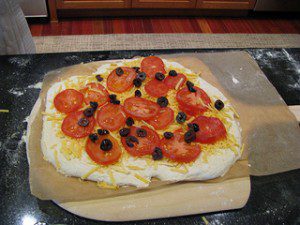By Gaye Levy
Guest writer for Wake Up World
If asked about comfort foods, many will say that pizza is number one on their list. And sure, waist line and health considerations not withstanding, I am human too and I do love pizza. But there are issues with both store bought and take-out pizza: chemicals, preservatives, processed ingredients and of course, cost. Now the greasy mess we typically sure does go down nice but the next day or even the next hour – well, it’s not so good.
As a big fan of Jeff Hertzberg and Zoe Francois and their Artisan Bread in Five books, I was absolutely thrilled when they published Artisan Pizza and Flatbread in Five Minutes a Day. I purchased the book in early June and since then I have been perfecting my own DIY pizza from scratch. In fact, I have been so busy making pizza that I have not had time to write about the it.But today is the day. I have gathered all my notes and all of my photos and will share with you the secret of making pizza at home, the Backdoor Survival way.
[pro_ad_display_adzone id=”110028″]
Starting with the basic pizza recipe
Before I share my own tips and observations with you, let us start with the basic recipe as I have adapted it for my own use.
Ingredients:
3 1/2 cups lukewarm water – about 100 degrees is perfect
1 tbsp. granulated yeast
1 to 1 1/2 tbsp. kosher salt
7 1/2 cups unbleached, all-purpose flour
Mixing the Dough
1. Warm the Water Slightly.
It should feel just a bit warmer than body temperature, about 100 degrees Fahrenheit. Using warm water allows the dough to rise to the right point for storage in about 2 hours. Cold water is okay too, but the initial rise will be longer.
2. Add Yeast and Salt.
Combine with the water in a 6-quart bowl or preferably, in a lidded (not airtight) plastic food container. Do not worry about getting the yeast and salt to dissolve completely.
3. Measure and Mix In the Flour.
Use the “scoop and sweep” method. This is done by reaching into the flour bin with your cup and scoop up a full measure all at once, then sweep it level with a knife. Mix in the flour with a wooden spoon or a dough whisk. Do not knead! You are finished with this step when everything is uniformly moistened and the dough is loose enough to conform to the container. 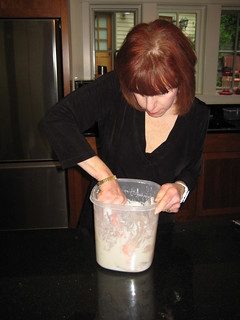
4. Allow the Dough to Rise.
Cover the dough with a lid but do not seal it airtight. Allow the dough to rise at room temperature until it begins to flatten on the top (approximately 2 hours, depending on the room’s temperature and the initial water temperature). Do not punch down the dough, do not play with it, do not do a thing. With this method, you are trying to retain as much gas in the dough as possible, and punching it down knocks out gas and will make your pizza dense – and who wants dense pizza?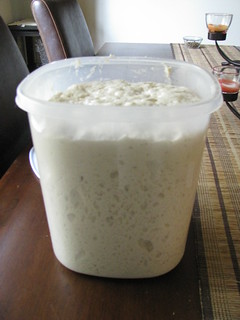
5. Refrigerate.
After the dough has risen, refrigerate it overnight or at least 3 hours and use it over the next 2 weeks. You can use it right away but it is a bit difficult to work with because it will be very sticky. Fully refrigerated dough is less sticky and is easier to work with than dough at room temperature. Note that after it’s chilled, the dough will collapse, and it won’t rise again in the bucket, which is normal.
Shaping and Baking the Pizza
6.Prepare and Measure Toppings.
Doing this in advance will help you top the pizza quickly so you can get it into the oven before it sticks to the pizza peel (more about the peel in the hints section).
7. Preheat a Baking Stone.
30 minutes before you’re ready to bake, place your baking stone in the bottom third of the oven and preheat it to the oven’s highest temperature. (On my oven that is 550 degrees F.) Note: If you do not have a peel, that’s okay – see my cast iron hint below.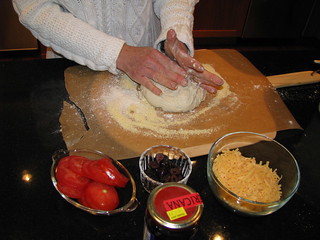
8. Shape a Ball.
First, prepare a pizza peel with flour, cornmeal or parchment paper to prevent your pizza from sticking to it. Sprinkle the surface of your refrigerated dough with flour. Pull up and cut off a half-pound (about the size of an orange) or larger piece of dough using a serrated knife. Add a little more flour to the dough as needed so it won’t stick to your hands.Gently stretch the surface of the dough around to the bottom on all 4 sides, rotating the dough a quarter-turn as you go, to form a ball. Most of the dusting flour will fall off which is okay – it is not intended to be incorporated into the dough. The bottom of the ball may appear to be a collection of bunched ends, but it will flatten out when you roll it into a pizza. This entire process should take no longer than 20 to 30 seconds. Yippee!
9. Roll Out and Stretch a Crust.
Flatten the dough with your hands and a rolling pin on the counter or directly onto the pizza peel (or shape the disk by hand) to produce a even 1/8th inch thick round, dusting it with dusting it with flour to keep the dough from adhering to your work surface.I prefer a thicker crust pizza so I use a larger chunk (cantaloupe sized) to begin with and roll the dough about 3/8 inch thick. When you’re finished, the pizza should be about 12 inches across and should have enough flour under it that it moves easily when you shake the peel.
10. Add the Toppings.
Spread your toppings over the dough. Get creative. My favorite is a “white” pizza with mozzarella, feta, Greek olives and fresh tomato but this is where you can make the pizza of your dreams with the toppings that you prefer. The final step is to drizzle a little olive oil over the pizza.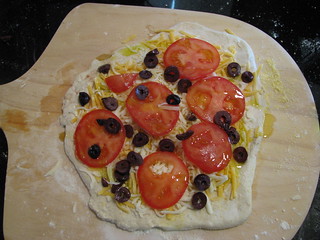
11. Slide the Pizza Onto the Preheated Stone.
Place the tip of the peel near the back of the stone, close to where you want the far edge of the pizza to land. Give the peel a few quick forward-and-back jiggles and then pull it sharply out from under the pizza.Warning: this is tricky. I either use parchment paper under the pizza and slide the paper on the stone or slide the dough into a cast iron skillet and add the toppings after the fact.
12. Bake the Pizza.
Check for doneness in 8 to 10 minutes. You can turn the pizza around in the oven if one side is browning faster than the other although this has never happened to me. Plus, I prefer my pizza somewhat browned if you will. Anyway, it may take up to 5 more minutes in the oven before the pizza is done.Using a spatula may be helpful in getting the baked pizza back onto the peel. Allow pizza to cool slightly — preferably on a wire cooling rack — so that the cheese sets.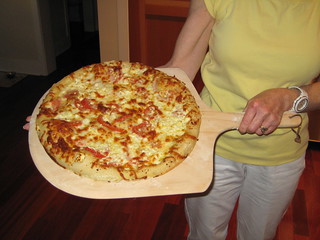
13. Serve it up!
Forget the pizza cutter. Use a pair of kitchen shears and cut the pizza the easy way!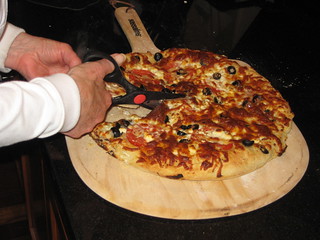 Hints from the Survival Woman Kitchen
Hints from the Survival Woman Kitchen
I have been making this pizza for a number of months and along the way I have learned some things. You will find some of my hints interspersed in the recipe but they are repeated here along with some additional tips. Warming the water to 100 degrees is easy in the microwave. I use an instant thermometer and 90 seconds does it. Your mileage may vary. Before I purchased the dough whisk, I had to use a lot of muscle to incorporate all of the flour into the liquid mixture. If you only about $9, it is cheap enough and well worth the cost.I have made pizza with the pizza stone and without. Truth? Baking on a pizza stone creates a nice crisp crust but if you do not have one, a cast iron skillet produces almost the same result. I have made pizza in both my 12” and my 15” skillet with good luck. What I do is roll out the dough on the peel, transfer it to the skillet, then add the toppings. If creating a skillet pizza, I often will use a drinking glass as a “rolling pin” to finish the doubt stretching process right in the pan. If you like a thicker pizza, let the dough rest for 5 or 10 minutes before adding the pizza. You can then do a final stretch of the dough and add your toppings. I don’t know why but this seems to make a thicker crust light and fluffy. A pizza peel is a great thing if you can afford one. I find it perfect for both rolling out the dough and also for serving up the final pizza. I would purchase this over the pizza stone in a heartbeat.The hot skillet – if you use one – is really really hot! Be sure to protect your hands and arms with oven mitts, preferably something Kevlar such as ove gloves. Let the pizza cool for about 5 minutes before slicing. This will give the cheese time to solidify. And forget the pizza cutter. A cheap pair of kitchen shears works a lot better.
Seeing Pizza Making in Action
I am lousy at making videos but for years I have been darn good at creating photostories.
Want to see pizza making in action?
Click below (also on YouTube). And don’t quit too soon – in the beginning you will see my first effort then towards the end, a more experienced version of the pizza making process plus the results!
The Final Word
This recipe was adapted from Artisan Pizza and Flatbread in Five Minutes a Day. The authors generously let other websites (and bloggers) publish recipes from the book that have been adapted by the writer (and are not verbatim from the book itself). I do recommend that you get the book since it is chock full of ideas and variations on the basic master recipe. Plus, it includes all types of flatbreads (pita, naan or breadsticks anyone?) and gluten free recipes as well.Now here is the best part. Zoe and Jeff actively participate in their website and if you are stumped and have a question or need help, they will answer you – typically within 1 or 2 days. Now how often do you see that. Not only that, they have lots of how-to videos on the sit not only for pizza but for their Artisan Bread in Five series as well.
Enjoy your next adventure through common sense and thoughtful preparation! Gaye
About the Author
Gaye Levy lives and teaches the principles of a sustainable, self-reliant and stylish lifestyle through emergency preparation and disaster planning. She does this through her website at BackdoorSurvival.com, an online preparedness blog that provides lifestyle tools, tips, and thoughts to guide you through the back door of life in the 21st century. With an emphasis on prepping and survival, she writes about and shares practical, thoughtful, and inspirational tools for survival in uncertain times.
Backdoor Survival is currently listed on the Survival Top 50. In addition, Gaye is a frequent guest on the Preparedness Radio Network and the soon to be author of a book on 21st century preparedness. Also known as SuvivalWoman, Gaye speaks her mind and delivers her message with optimism and grace, regardless of mayhem swirling around us.
You can find Gaye through her website at Backdoor Survival, on the Backdoor Survival Page on Facebook, and as Survival Woman on Twitter.
[pro_ad_display_adzone id=”110027″]

